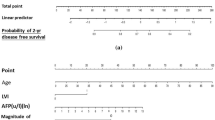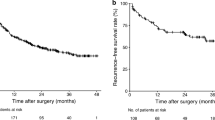Abstract
The currently used criteria, such as the Milan criteria, to select a candidate of liver transplantation for HCC consists of size and number of tumors because vascular invasion and poor differentiation, the strongest prognostic factors, are difficult to be assessed preoperatively. We hypothesized that inclusion of two tumor markers (alpha-fetoprotein and des-γ-carboxy prothrombin) into the criteria would increase the prediction accuracy of these factors. Our hypothesis was tested in 478 HCC patients undergoing liver resection. The models with or without markers, constructed at predicting vascular invasion (n = 150) or poor differentiation (n = 49), were compared. The model including markers was superior at predicting the absence of vascular invasion to either the Milan criteria alone [at 81.2% sensitivity; specificity, 52.4 vs 43.3%; difference, 9.1%(95% CI, 1.3–14.2%)] or a model in which size and number varied freely [AUCs of receiver operating characteristic curves, 75.2 vs 69.1%; difference, 6.1%(2.33–10.7%)]. The model incorporating markers was also superior at predicting well to moderate differentiation to either the Milan criteria [at 74.5% sensitivity; specificity, 57.1 vs 38.8%; difference, 18.3%(2.4–32.7%)] or a model with size and number [AUCs, 71.5 vs 59.0%; difference, 12.5%(5.84–21.4%)]. In conclusion, the tumor marker levels should be considered when selecting patients with HCC for liver transplantation.



Similar content being viewed by others
Abbreviations
- HCC:
-
hepatocellular carcinoma
- UCSF:
-
University of California at San Francisco
- AFP:
-
alpha-fetoprotein
- DCP:
-
des-γ-carboxy prothrombin
- ROC:
-
receiver operating characteristic
- AUC:
-
area under the curve
References
Llovet JM, Schwartz M, Mazzaferro V. Resection and liver transplantation for hepatocellular carcinoma. Semin Liver Dis 2005;25:181–200.
Bruix J, Sherman M. Management of hepatocellular carcinoma. Hepatology 2005;42:1208–1236.
Schwartz M. Liver transplantation for hepatocellular carcinoma. Gastroenterology 2004;127:S268–S276.
Bismuth H, Chiche L, Adam R, Castaing D, Diamond T, Dennison A. Liver resection versus transplantation for hepatocellular carcinoma in cirrhotic patients. Ann Surg 1993;218:145–151.
Mazzaferro V, Regalia E, Doci R, et al. Liver transplantation for the treatment of small hepatocellular carcinoma in patients with cirrhosis. N Engl J Med 1996;334:693–699.
Sharma P, Balan V, Hernandez JL, Harper AM, Edwards EB, Rodriguez-Luma H, Byrne T, et al. Liver transplantation for hepatocellular carcinoma: the MELD impact. Liver Transplant 2004;10:36–41.
UNOS data. http://www.optn.org/resources/bioethics.asp?index=8.
Yao FY, Ferrell L, Bass NM, Watson JJ, Bacchetti P, Venook A, Ascher NL, et al. Liver transplantation for hepatocellular carcinoma: expansion of the tumor size limits does not adversely impact survival. Hepatology 2001;33:1394–1403.
Margarit C, Charco R, Hidalgo E, Allende H, Castells L, Bilbao I. Liver transplantation for malignant diseases: selection and pattern of recurrence. World J Surg 2002;26:257–263.
Shetty K, Timmins K, Brensinger C, Furth EE, Rattan S, Sun W, Rosen M, et al. Liver transplantation for hepatocellular carcinoma validation of present selection criteria in predicting outcome. Liver Transplant 2004;10:911–918.
Marsh JW, Dvorchik I, Bonham CA, Iwatsuki S. Is the pathologic TNM staging system for patients with hepatoma predictive of outcome? Cancer 2000;88:538–543.
Hemming AW, Cattral MS, Reed AI, Vand der Werf WJ, Greig PD, Howard RJ. Liver transplantation for hepatocellular carcinoma. Ann Surg 2001;233:652–659.
Figueras J, Ibanez L, Ramos E, Jaurrieta E, Ortiz-de-Urbina J, Pardo F, Mir J, et al. Selection criteria for liver transplantation in early-stage hepatocellular carcinoma with cirrhosis: results of a multicenter study. Liver Transplant 2001;7:877–883.
Imamura H, Matsuyama Y, Tanaka E, Ohkubo T, Hasegawa K, Miyagawa S, Sugawara Y, et al. Risk factors contributing early and late phase intrahepatic recurrence hepatocellular carcinoma after hepatectomy. J Hepatol 2003;38:200–207.
Vauthey JN, Klimstra D, Franceschi D, Tao Y, Fortner J, Blumgart L, Brenman M. Factors affecting long-term outcome after hepatic resection for hepatocellular carcinoma. Am J Surg 1995;169:28–34.
Arii S, Okamoto E, Imamura M. Registries in Japan: current status of hepatocellular carcinoma in Japan. Liver Cancer Study Group of Japan. Semin Surg Oncol 1996;12:204–211.
Shimada M, Takenaka K, Fujiwara Y, Gion T, Kajiyama K, Maeda T, Shirabe K, et al. Des-gamma-carboxy prothrombin and alpha-fetoprotein positive status as a new prognostic indicator after hepatic resection for hepatocellular carcinoma. Cancer 1996;78:2094–2100.
Imamura H, Matsuyama Y, Miyagawa Y, Ishida K, Shimada R, Miyagawa S, Makuuchi M, et al. Prognostic significance of anatomical resection and des-γ-carboxy prothrombin in patients with hepatocellular carcinoma. Br J Surg 1999;86:1032–1038.
Tsai TJ, Chau GY, Lui WY, Tsay SH, King KL, Loong CC, Hsia CY, et al. Clinical significance of microscopic tumor venous invasion in patients with resectable hepatocellular carcinoma. Surgery 2000;127:603–608.
Hasegawa K, Kokudo N, Imamura H, Matsuyama Y, Aoki T, Minagawa M, Sano K, et al. Prognostic impact of anatomic resection for hepatocellular carcinoma. Ann Surg 2005;242:252–259.
Klintmalm GB. Liver transplantation for hepatocellular carcinoma a registry report of the impact of tumor characteristics on outcome. Ann Surg 1998;228:479–490.
Tamura S, Kato T, Berho M, Misiakos EP, O’Brien C, Reddy R, Nery JR, et al. Impact of histological grade of hepatocellular carcinoma on the outcome of liver transplantation. Arch Surg 2001;136:25–30.
Jonas S, Bechstein WO, Steinmuller T, Herrmann M, Radke C, Berg T, Settmacher U, et al. Vascular invasion and histopathologic grading determine outcome after liver transplantation for hepatocellular carcinoma in cirrhosis. Hepatology 2001;33:1080–1086.
Cillo U, Vitale A, Bassanello M, Boccagni P, Brolese A, Zanus G, Burra P, et al. Liver transplantation for the treatment of moderately or well-differentiated hepatocellular carcinoma. Ann Surg 2004;239:150–159.
Esnaola NF, Lauwers GY, Mirza NQ, Nagorney DM, Doherty D, Ikai I, et al. Predictors of microvascular invasion in patients with hepatocellular carcinoma: who are candidates for orthotopic liver transplantation. J Gastointest Surg 2002;6:224–232.
Pawlik TM, Delman KA, Vauthey J-N, Nagorney DM, Ng IO-L, Ikai I, et al. Tumor size predicts vascular invasion and histologic grade: implications for section of surgical treatment for hepaticellular carcinoma. Liver Transplant 2005;11:1086–1092.
Deyashiki Y, Nishioka Y, Takahashi K, Kosaka Y, Suzuki K. Evaluation of des-gamma-carboxy prothrombin as a marker protein of hepatocellular carcinoma. Cancer 1989;64:2546–2551.
Fujiyama S, Izuno K, Gohshi K, Shibata J, Sato T. Clinical usefulness of des-gamma-carboxy prothrombin assay in early diagnosis of hepatocellular carcinoma. Dig Dis Sci 1991;36:1787–1792.
Kasahara A, Hayashi N, Fusamoto H, Kawada Y, Imai Y, Yamamoto H, Hayashi E, et al. Clinical evaluation of plasma des-gamma-carboxy prothrombin as a marker protein of hepatocellular carcinoma in patients with tumors of various sizes. Dig Dis Sci 1993;38:2170–2176.
Inoue S, Nakao A, Harada A, Nonami T, Takagi H. Clinical significance of abnormal prothrombin (DCP) in relation to postoperative survival and prognosis in patients with hepatocellular carcinoma. Am J Gastroenterol 1994;89:2222–2226.
Grazi GL, Mazziotti A, Legnani C, Jovine E, Miniero R, Gallucci A, Palareti G, et al. The role of tumor markers in the diagnosis of hepatocellular carcinoma, with special reference to the des-gamma carboxyprothrombin. Liver Transplant Surg 1995;1:249–255.
Marrero JA, Su GL, Wei W, Emick D, Conjeevaram HS, Fontana RJ, Lok AS. Des-gamma carboxyprothrombin can differentiate hepatocellular carcinoma from nonmalignant chronic liver disease in American patients. Hepatology 2003;37:1114–1121.
Cui R, He J, Zhang F, Wang B, Ding H, Shen H, Li Y, et al. Diagnostic value of protein induced by vitamin K absence (PIVKA II) and hepatoma-specific band of serum gamma-glutamyl transferase (GGT II) as hepatocellular carcinoma markers complementary to α-fetoprotein. Br J Cancer 2003;88:1878–1882.
Sakon M, Monden M, Gotoh M, Kanai T, Umeshita K, Nakano Y, Mori T, et al. Relationship between pathologic prognostic factors and abnormal levels of des-gamma-carboxy prothrombin and alpha-fetoprotein in hepatocellular carcinoma. Am J Surg 1992;163:251–256.
Torzilli G, Minagawa M, Takayama T, Inoue K, Hui AM, Kubota K, Ohtomo K, et al. Accurate preoperative evaluation of liver mass lesions without fine-needle biopsy. Hepatology 1999;30:889–893.
Makuuchi M, Hasegawa H, Yamazaki S. Ultrasonically guided subsegmentectomy. Surg Gynecol Obstet 1985;161:346–350.
Nakashima T, Kojiro M. Pathologic characteristics of hepatocellular carcinoma. Semin Liver Dis 1986;6:259–266.
Liver Cancer Study Group of Japan. The general rules for the clinical and pathological study of primary liver cancer. 4th ed. Tokyo: Kanehara and Co. Ltd, 2000.
Belanger L, Sylvestre C, Dufour D. Enzyme-linked immunoassay for alpha-fetoprotein by competitive and sandwich procedures. Clin Chim Acta 1973;48:15–18.
Liebman HA, Furie BC, Tong MJ, Blanchard RA, Lo KJ, Lee SD, et al. Des-gamma-carboxy (abnormal) prothrombin as a serum marker of primary hepatocellular carcinoma. N Engl J Med 1984;310:1427–1431.
Nomura F, Ishijima M, Kuwa K, Tanaka N, Nakai T, Ohnishi K. Serum des-gamma-carboxy prothrombin levels determined by a new generation of sensitive immunoassays in patients with small-sized hepatocellular carcinoma. Am J Gastroenterol 1999;94:650–654.
Armitage P, Berry G, Matthews JNS. Statistical methods in medical research. 4th ed. Oxford: Blackwell Science, 2002.
Griner PF, Mayewsi RJ, Mushlin AI, Greenland P. Selection and interpretation of diagnostic tests and procedures. Ann Intern Med 1981;94:555–600.
Metsz CE. Basic principles of ROC analysis. Semin Nucl Med 1998;8:283–298.
Leung JY, Zhu AX, Gordon FD, Pratt DS, Mithoefer A, Garrigan K, Terella A, et al. Liver transplantation outcomes for early-stage hepatocellular carcinoma: results of a multicenter study. Liver Transplant 2004;10:1343–1354.
Plessier A, Codes L, Consigny Y, Sommacale D, Dondero F, Cortes A, Degos F, et al. Underestimation of the influence of satellite nodules as a risk factor for post-transplantation recurrence in patients with small hepatocellular carcinoma. Liver Transplant 2004;10:S86-S90.
Yao Y, Bass N, Nikokai B, Davern TJ, Kerlan R, Wu V, Ascher NL, et al. Liver transplantation for hepatocellular carcinoma: analysis of survival according to the intention-to-treat principle and dropout from the waiting list. Liver Transplant 2002;8:873–883.
Kar S, Carr BI. Detection of liver cells in peripheral blood of patients with advanced-stage heptocellular carcinoma. Hepatology 1995;21:403–407.
Kienle P, Weitz J, Klaes R, Koch M, Benner A, Lehnert T, Herfarth C, et al. Detection of isolated disseminated tumor cells in bone marrow and blood samples of patients with hepatocellular carcinoma. Arch Surg 2000;135:213–218.
Chen YJ, Yeh SH, Chen JT, Wu CC, Hsu MT, Tsai SF, Chen PJ, et al. Chromosomal changes and clonality relationship between primary and recurrent hepatocellular carcinoma. Gastroenterology 2000;119:431–440.
Ng IO, Guan XY, Poon RT, Fan ST, Lee JM. Determination of the molecular relationship between multiple tumour nodules in hepatocellular carcinoma differentiates multicentric origin from intrahepatic metastasis. J Pathol 2003;199:345–353.
Takamori R, Wong LL, Dang C, Wong L. Needle-tract implantation from hepatocellular cancer: is needle biopsy of the liver always necessary? Liver Transplant 2000;6:67–72.
Marrero JA, Lok AS. Newer markers for hepatocellular carcinoma. Gastroenterology 2004;127:S113–S119.
Alpert E, Hershberg R, Schur PH, Isselbacher KJ. Alpha-fetoprotein in human hepatoma: improved detection in serum, and quantitative studies using a new sensitive technique. Gastroenterology 1971;61:137–143.
Chen MF, Hwang TL, Jeng LB, Jan YY, Wang CS, Chou FF. Hepatic resection in 120 patients with hepatocellular carcinoma. Arch Surg 1989;124:1025–1028.
Belghiti J, Panis Y, Farges O, Benhamou JP, Fekete F. Intrahepatic recurrence after resection of hepatocellular carcinoma complicating cirrhosis. Ann Surg 1991;214:114–117.
Acknowledgment
This work was supported by a grant from the Mitsui Life Social Welfare Foundation, a grant from the Kanae Foundation for Life and Socio-Medical Science, and a grant-in-aid for Scientific Research from the Ministry of Education, Culture, Sports, Science and Technology of Japan (grant no. 18790955) in Japan.
Author information
Authors and Affiliations
Corresponding author
Rights and permissions
About this article
Cite this article
Hasegawa, K., Imamura, H., Ijichi, M. et al. Inclusion of Tumor Markers Improves the Correlation of the Milan Criteria with Vascular Invasion and Tumor Cell Differentiation in Patients with Hepatocellular Carcinoma Undergoing Liver Resection (#JGSU-D-07–00462). J Gastrointest Surg 12, 858–866 (2008). https://doi.org/10.1007/s11605-007-0464-9
Received:
Accepted:
Published:
Issue Date:
DOI: https://doi.org/10.1007/s11605-007-0464-9




